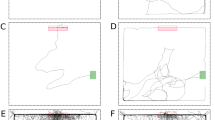Abstract
Wing movements associated with stridulation by the male during cricket courtship generate air movements that have been proposed to serve as signals to the female. We assessed this putative signaling role by interfering with the presumed communications channel in two ways: (1) by removing the female's cerci, which are candidate sensory organs for signal reception, and (2) by trimming the male's forewings and thus manipulating the signal itself. We measured the effects of these treatments on the probability and latency with which females mounted courting males. We found that neither treatment affected female mounting behavior. This was true both for old, highly motivated females and for younger females, which are less highly motivated and possibly more selective. We conclude that air movements play little or no role as signals that release female mounting behavior during courtship.
Similar content being viewed by others
Author information
Authors and Affiliations
Additional information
Accepted: 11 June 1998
Rights and permissions
About this article
Cite this article
Pollack, G., Givois, V. & Balakrishnan, R. Air-movement `signals' are not required for female mounting during courtship in the cricket Teleogryllus oceanicus. J Comp Physiol A 183, 513–518 (1998). https://doi.org/10.1007/s003590050276
Issue Date:
DOI: https://doi.org/10.1007/s003590050276




